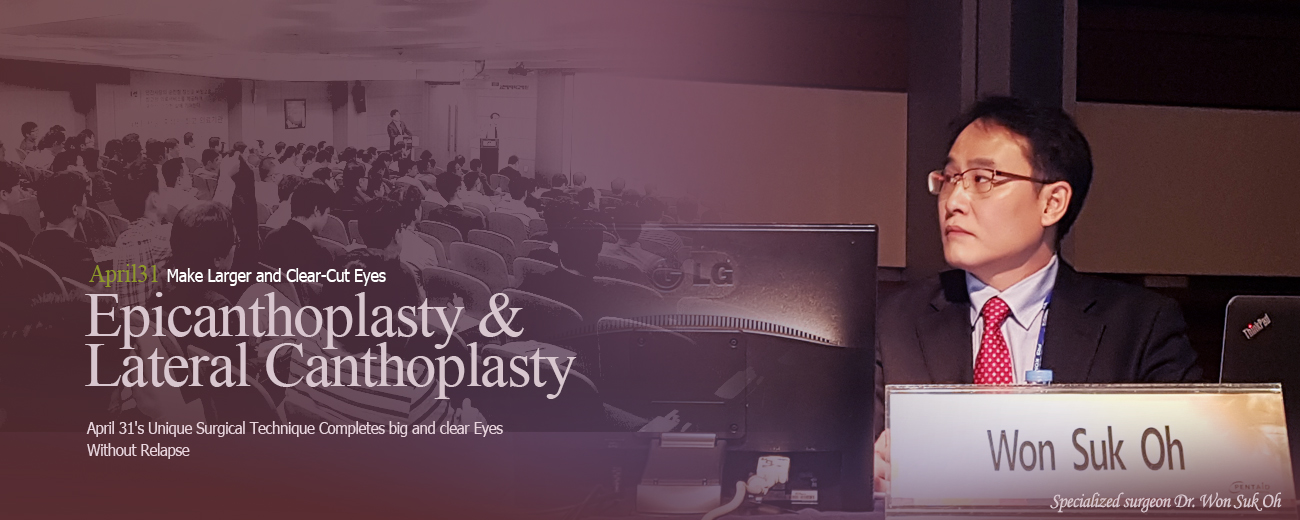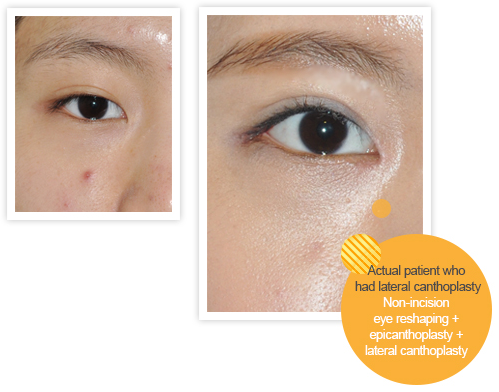
◆ Surgical information
Specialized surgeon: Dr. Won Suk Oh
Anesthesia :IV Sedation + Local Anesthesia
Post operative treatment visits : 3-4 times
Stitch removal : In 7 days
Recovery Care : Bruising and swelling care
◆ What is Epicanthoplasty - Medial and Lateral
|
1. Medial Epicanthoplasty The procedure removes Mongolian folds that obstruct the inner corner of the eyes. Epicanthoplasty reveals more eyes and part of lachrymal glands by cutting off Mongolian folds (epicanthic folds) that overly cover the inner corner of the eye, creating larger and clearer-cut eyes. |
2. Lateral Epicanthoplasty If the width of eyes are short compared to the height, the eyes look centered in the middle of the face, and this can't be corrected with only double eyelid surgery. If both eyes are pushed into the inner corner of the eyes, lateral canthoplasty enlarges the outer corner of the eyes to increase the overall size of the eyes. The overly covered outer angle of the eye is extended through resection on the skin and mucous membrane to make wider and deep-set eyes. |
|
◆ Candidates
for Epicanthoplasty
01. Those who have small eyes with short width
02. Those who have obstructed inner or outer corner of eyes
03. Those who had double eyelid surgery but whose eyes still looks undefined.
04. Complete Natural-Looking Eye Shape using a Precise and Safe Method
◆ Surgical Method of Medial and Lateral Epicanthoplasty
Complete Natural-Looking Eye Shape with Precise and Safe Method | |||||||||||||
01. Non-incision Double eyelid The conventional epicanthoplasty leaves a scar because it focuses on simple resection and relocation of the skin. April 31's epicanthoplasty produces a natural-looking and well-defined eye shape without side effects through skin repositioning that minimizes tension.
| |||||||||||||
02. Partial incision Double eyelid April 31's Three-Way Eye Enlargement Surgery that Doesn't Come Undone Excessive skin and membrane resection causes a high risk of relapse. To prevent relapse, not excessive but moderate resection and correction method is important. April 31 Plastic Surgery performs Three-Way Eye Enlargement Surgery (lateral canthal surgery) that detaches lateral canthal ligament and fixes it to a new position in order to prevent relapse and make moderate correction.
| |||||||||||||
◆ Advantages of April 31's Lateral Canthoplasty
April 31's Unique Technique without Relapse
point 01 |
point 02 |
point 03 |
Changes rough and hostile image into soft one | There is a lower risk of fold coming undone | There is low risk of side effects including scarring |
Point 04 |
point 05 |
point 06 |
Enlarges the size of the eyes more effectively than regular canthoplasty | Create distinct, clear-cut eyes | Correct upward or downward eye slant |
◆ Treatment Plan

01. Examine facial sructure and condition | 02. Consult with eye-surgery Specialist Dr. Wonsuk Oh | 03. Devise a surgery plan suitable for each patient | 04. Perform surgery and monitor recovery |






